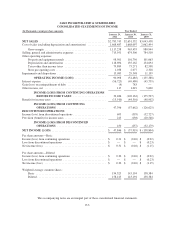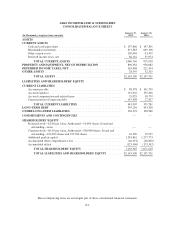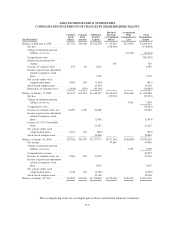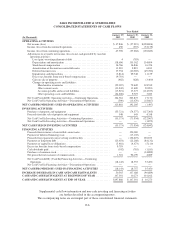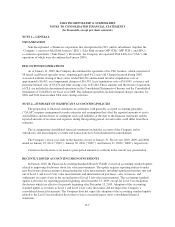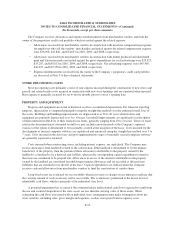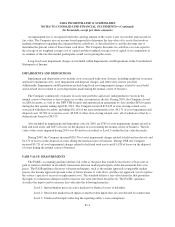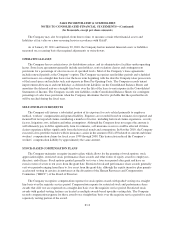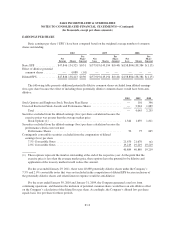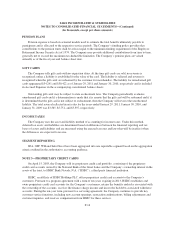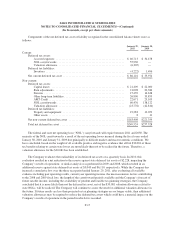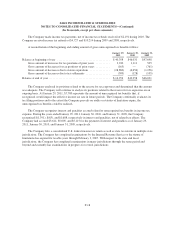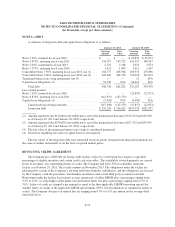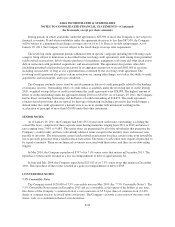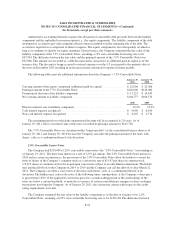Saks Fifth Avenue 2010 Annual Report Download - page 62
Download and view the complete annual report
Please find page 62 of the 2010 Saks Fifth Avenue annual report below. You can navigate through the pages in the report by either clicking on the pages listed below, or by using the keyword search tool below to find specific information within the annual report.SAKS INCORPORATED & SUBSIDIARIES
NOTES TO CONSOLIDATED FINANCIAL STATEMENTS—(Continued)
(In thousands, except per share amounts)
The Company may also be required, from time to time, to measure certain other financial assets and
liabilities at fair value on a non-recurring basis in accordance with GAAP.
As of January 29, 2011 and January 30, 2010, the Company had no material financial assets or liabilities
measured on a recurring basis that required adjustments or write-downs.
OPERATING LEASES
The Company leases certain stores, its distribution centers, and its administrative facilities under operating
leases. Store lease agreements generally include rent holidays, rent escalation clauses and contingent rent
provisions for a percentage of sales in excess of specified levels. Most of the Company’s lease agreements
include renewal periods at the Company’s option. The Company recognizes rent holiday periods and scheduled
rent increases on a straight-line basis over the lease term beginning with the date the Company takes possession
of the leased space and includes such rent expense in Store Pre-Opening Costs. The Company records tenant
improvement allowances and rent holidays as deferred rent liabilities on the Consolidated Balance Sheets and
amortizes the deferred rent on a straight–line basis over the life of the lease to rent expense in the Consolidated
Statements of Income. The Company records rent liabilities on the Consolidated Balance Sheets for contingent
percentage of sales lease provisions when the Company determines that it is probable that the specified levels
will be reached during the fiscal year.
SELF-INSURANCE RESERVES
The Company self-insures a substantial portion of its exposure for costs related primarily to employee
medical, workers’ compensation and general liability. Expenses are recorded based on estimates for reported and
incurred but not reported claims considering a number of factors, including historical claims experience, severity
factors, litigation costs, inflation and other assumptions. Although the Company does not expect the amount it
will ultimately pay to differ significantly from its estimates, self-insurance reserves could be affected if future
claims experience differs significantly from the historical trends and assumptions. In October 2010, the Company
executed a loss portfolio transfer with its insurance carrier in the amount of $11,450 related to current and future
workers’ compensation claims for fiscal years 1999 through 2008. This transaction reduced the Company’s
workers’ compensation liability by approximately the same amount.
STOCK-BASED COMPENSATION PLANS
The Company maintains an equity incentive plan, which allows for the granting of stock options, stock
appreciation rights, restricted stock, performance share awards and other forms of equity awards to employees,
directors, and officers. Stock options granted generally vest over a four-year period after grant and have an
exercise term of seven to ten years from the grant date. Restricted stock and performance share awards generally
vest over periods ranging from three to five years from the grant date, although the equity incentive plan permits
accelerated vesting in certain circumstances at the discretion of the Human Resources and Compensation
Committee (“HRCC”) of the Board of Directors.
The Company recognizes compensation expense for stock option awards with graded vesting on a straight
line basis over the requisite service period. Compensation expense for restricted stock and performance share
awards that cliff vest are expensed on a straight-line basis over the requisite service period. Restricted stock
awards with graded-vesting features are treated as multiple awards based upon the vesting date. The Company
records compensation expense for these awards on a straight-line basis over the requisite service period for each
separately vesting portion of the award.
F-12



